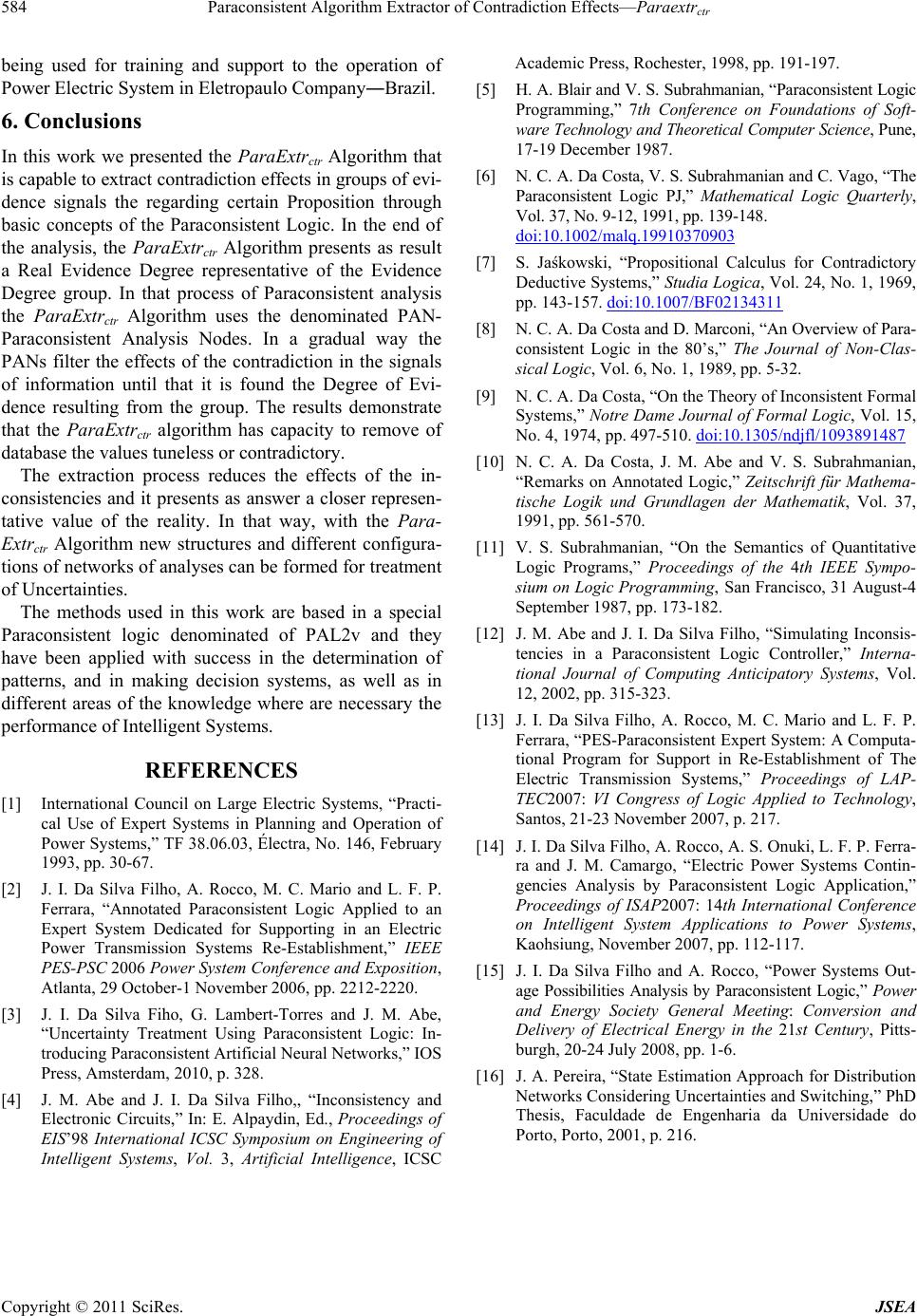
Paraconsistent Algorithm Extractor of Contradiction Effects—Paraextr
584 ctr
being used for training and support to the operation of
Power Electric System in Eletropaulo Company―Brazil.
6. Conclusions
In this work we presented the ParaExtrctr Algorithm that
is capable to extract contradiction effects in groups of evi-
dence signals the regarding certain Proposition through
basic concepts of the Paraconsistent Logic. In the end of
the analysis, the ParaExtrctr Algorithm presents as result
a Real Evidence Degree representative of the Evidence
Degree group. In that process of Paraconsistent analysis
the ParaExtrctr Algorithm uses the denominated PAN-
Paraconsistent Analysis Nodes. In a gradual way the
PANs filter the effects of the contradiction in the signals
of information until that it is found the Degree of Evi-
dence resulting from the group. The results demonstrate
that the ParaExtrctr algorithm has capacity to remove of
database the values tuneless or contradictory.
The extraction process reduces the effects of the in-
consistencies and it presents as answer a closer represen-
tative value of the reality. In that way, with the Para-
Extrctr Algorithm new structures and different configura-
tions of networks of analyses can be formed for treatment
of Uncertainties.
The methods used in this work are based in a special
Paraconsistent logic denominated of PAL2v and they
have been applied with success in the determination of
patterns, and in making decision systems, as well as in
different areas of the knowledge where are necessary the
performance of Intelligent Systems.
REFERENCES
[1] International Council on Large Electric Systems, “Practi-
cal Use of Expert Systems in Planning and Operation of
Power Systems,” TF 38.06.03, Électra, No. 146, February
1993, pp. 30-67.
[2] J. I. Da Silva Filho, A. Rocco, M. C. Mario and L. F. P.
Ferrara, “Annotated Paraconsistent Logic Applied to an
Expert System Dedicated for Supporting in an Electric
Power Transmission Systems Re-Establishment,” IEEE
PES-PSC 2006 Power System Conference and Exposition,
Atlanta, 29 October-1 November 2006, pp. 2212-2220.
[3] J. I. Da Silva Fiho, G. Lambert-Torres and J. M. Abe,
“Uncertainty Treatment Using Paraconsistent Logic: In-
troducing Paraconsistent Artificial Neural Networks,” IOS
Press, Amsterdam, 2010, p. 328.
[4] J. M. Abe and J. I. Da Silva Filho,, “Inconsistency and
Electronic Circuits,” In: E. Alpaydin, Ed., Proceedings of
EIS’98 International ICSC Symposium on Engineering of
Intelligent Systems, Vol. 3, Artificial Intelligence, ICSC
Academic Press, Rochester, 1998, pp. 191-197.
[5] H. A. Blair and V. S. Subrahmanian, “Paraconsistent Logic
Programming,” 7th Conference on Foundations of Soft-
ware Technology and Theoretical Computer Science, Pune,
17-19 December 1987.
[6] N. C. A. Da Costa, V. S. Subrahmanian and C. Vago, “The
Paraconsistent Logic PJ,” Mathematical Logic Quarterly,
Vol. 37, No. 9-12, 1991, pp. 139-148.
doi:10.1002/malq.19910370903
[7] S. Jaśkowski, “Propositional Calculus for Contradictory
Deductive Systems,” Studia Logica, Vol. 24, No. 1, 1969,
pp. 143-157. doi:10.1007/BF02134311
[8] N. C. A. Da Costa and D. Marconi, “An Overview of Para-
consistent Logic in the 80’s,” The Journal of Non-Clas-
sical Logic, Vol. 6, No. 1, 1989, pp. 5-32.
[9] N. C. A. Da Costa, “On the Theory of Inconsistent Formal
Systems,” Notre Dame Journal of Formal Logic, Vol. 15,
No. 4, 1974, pp. 497-510. doi:10.1305/ndjfl/1093891487
[10] N. C. A. Da Costa, J. M. Abe and V. S. Subrahmanian,
“Remarks on Annotated Logic,” Zeitschrift für Mathema-
tische Logik und Grundlagen der Mathematik, Vol. 37,
1991, pp. 561-570.
[11] V. S. Subrahmanian, “On the Semantics of Quantitative
Logic Programs,” Proceedings of the 4th IEEE Sympo-
sium on Logic Programming, San Francisco, 31 August-4
September 1987, pp. 173-182.
[12] J. M. Abe and J. I. Da Silva Filho, “Simulating Inconsis-
tencies in a Paraconsistent Logic Controller,” Interna-
tional Journal of Computing Anticipatory Systems, Vol.
12, 2002, pp. 315-323.
[13] J. I. Da Silva Filho, A. Rocco, M. C. Mario and L. F. P.
Ferrara, “PES-Paraconsistent Expert System: A Computa-
tional Program for Support in Re-Establishment of The
Electric Transmission Systems,” Proceedings of LAP-
TEC2007: VI Congress of Logic Applied to Technology,
Santos, 21-23 November 2007, p. 217.
[14] J. I. Da Silva Filho, A. Rocco, A. S. Onuki, L. F. P. Ferra-
ra and J. M. Camargo, “Electric Power Systems Contin-
gencies Analysis by Paraconsistent Logic Application,”
Proceedings of ISAP2007: 14th International Conference
on Intelligent System Applications to Power Systems,
Kaohsiung, November 2007, pp. 112-117.
[15] J. I. Da Silva Filho and A. Rocco, “Power Systems Out-
age Possibilities Analysis by Paraconsistent Logic,” Power
and Energy Society General Meeting: Conversion and
Delivery of Electrical Energy in the 21st Century, Pitts-
burgh, 20-24 July 2008, pp. 1-6.
[16] J. A. Pereira, “State Estimation Approach for Distribution
Networks Considering Uncertainties and Switching,” PhD
Thesis, Faculdade de Engenharia da Universidade do
Porto, Porto, 2001, p. 216.
Copyright © 2011 SciRes. JSEA